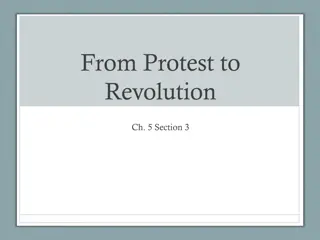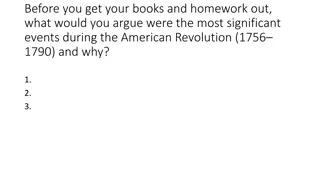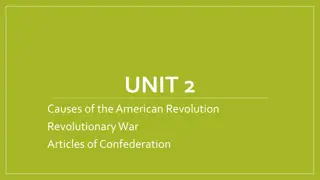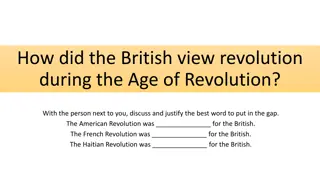Leaders of the American Revolution
Leadership in the American Revolution was exemplified by prominent figures such as Benjamin Franklin, John Adams, Thomas Jefferson, and George Washington. These leaders played vital roles in shaping the nation's history through their political, scientific, and diplomatic contributions.
Download Presentation

Please find below an Image/Link to download the presentation.
The content on the website is provided AS IS for your information and personal use only. It may not be sold, licensed, or shared on other websites without obtaining consent from the author. Download presentation by click this link. If you encounter any issues during the download, it is possible that the publisher has removed the file from their server.
E N D
Presentation Transcript
What is Leadership Leadership has been described as a process of social influence in which one person can enlist the aid and support of others in the accomplishment of a common goal. For example, some understand a leader simply as somebody who people follow, or as somebody who guides or directs others, while others define leadership as organizing a group of people to achieve a common goal. Studies of leadership have produced theories involving traits, situational interaction, function, behavior, power, vision and values charisma, and intelligence, among others.
Ben Franklin Benjamin Franklin was a successful, impressive, and inspiring politician, statesman, author, publisher, scientist, and philosopher. Some of his other accomplishments were: Inventing bi-focal glasses Served as America's first postmaster Inventing the Franklin Stove Inventing the lightning rod and not getting a patent, so as to make them affordable Proved that lightning electricity can be harnessed Started a lending library and fire station Basically, he helped us win the Revolution and establish a government afterward, improved and/or saved the lives of many people, laid the electrical groundwork out for most all scientific advancements to date.
John Adams John Adams (1735-1826) was a leader of the American Revolution, and served as the second U.S. president from 1797 to 1801. The Massachusetts-born, Harvard-educated Adams began his career as a lawyer. Intelligent, patriotic, opinionated and blunt, Adams became a critic of Great Britain's authority in colonial America and viewed the British imposition of high taxes and tariffs as a tool of oppression. During the 1770s, he was a delegate to the Continental Congress. In the 1780s, Adams served as a diplomat in Europe and helped negotiate the Treaty of Paris (1783), which officially ended the American Revolutionary War (1775-83). From 1789 to 1797, Adams was America's first vice president. He then served a term as the nation's second president.
Thomas Jefferson Thomas Jefferson was the author of the Declaration of Independence and the third U.S. president. During the American Revolutionary War (1775-83), Jefferson served in the Continental Congress and was governor of Virginia. Jefferson, who thought the national government should have a limited role in citizens' lives, was elected president in 1800. During his term in office the U.S. purchased the Louisiana Territory. Although Jefferson promoted individual liberty, he was also a slave owner. *Special Note, John Adams and Thomas Jefferson both died on the same day, July the 4th 1826, 50 years after the signing of the Declaration of Independence
George Washington George Washington was the first president of the United States, Commanding General during the American Revolution and remains as one of the most influential and famous figures in American history. His contribution extends far beyond perhaps any other in the history of the United States. By 1774, Washington had become a key supporter of the colonial cause and was elected to the First Continental Congress. The next year, the Second Continental Congress voted Washington to be the commander of their army, and Washington's military career was born anew. He led the Continental Army against the mighty British Army as they began their fight for independence. In 1796, Washington declared that he would not serve a third term. He attended the inauguration of John Adams then retired to Mount Vernon.
The Marquis de Lafayette The Marquis de Lafayette was born in 1757, in France. He served the Continental Army with distinction during the American Revolutionary War, providing tactical leadership while securing vital resources from France. Inspired by stories of the colonists' struggles against British oppression, Lafayette sailed to the newly declared United States in 1777 to join the uprising. He was initially rebuffed by colonial leaders, but he impressed them with his passion and willingness to serve for free, and was named a major- general in the Continental Army. Following a winter in Valley Forge with Washington, Lafayette established his credentials as an intelligent leader while helping to draw more French resources to the colonial side. In May 1778, he outwitted the British sent to capture him at Bunker Hill, later renamed Lafayette Hill, and rallied a shaky Continental attack at Monmouth Courthouse to force a stalemate.
George Rogers Clark George Rogers Clark is remembered as the heroic Revolutionary War commander who led a small force of frontiersmen through the freezing waters of the Illinois country to capture British-held Fort Sackville at Vincennes during February 1779. Although this was Clark's most dramatic accomplishment, he continued his exertions on behalf of the American cause in the West during the entire war. These efforts included building forts on the Mississippi and Ohio rivers, repelling a British-led Indian attack in the Illinois country, and leading two major expeditions that destroyed the major Shawnee towns in the Ohio country.
John Paul Jones On April 10, 1778, Commander John Paul Jones and his crew set sail on the first mission of its kind during the Revolutionary War. Commander Jones is remembered as one of the most daring and successful naval commanders of the American Revolution In September 1779, Jones fought one of the fiercest battles in naval history. In an engagement with the 50-gun British warship the American ship was struck, it began taking on water and caught fire. When the British captain ordered Jones to surrender, he famously replied, "I have not yet begun to fight!" A few hours later, the British captain and crew admitted defeat and Jones took command of the British ship. One of the greatest naval commanders in history, Jones is remembered as a "Father of the American Navy". John Paul Jones is buried in a crypt at the U.S. Naval Academy Chapel in Annapolis, where a Marine honor guard stands at attention in his honor whenever the crypt is open to the public.
Nathan Hale Nathan Hale attended college at Yale University in New Haven, Connecticut from when he was 14 until the time he was 16 He graduated from Yale and became a teacher at age 18. At the beginning of the Revolutionary War in 1775, he was promoted to Captain. He took the position of Captain on the Rangers group. The Rangers were known for their bravery and courage in dangerous missions. In September of 1776, George Washington was planning to infiltrate the British by going behind enemy lines in New York. Once Nathan Hale heard about this, he immediately went to his superior who was Major Thomas Knowlton. The plan was set into action. Nathan Hale went behind the enemy lines disguised as a Dutch Schoolmaster. He successfully penetrated the British in New York. He recovered very important military information. Unfortunately, on September 21, 1776, the night he was planning to go home, he was arrested by British Soldiers. The arrest was supposedly linked with the betrayal of his loyalist cousin. Commander-in-Chief of the British, General William Howe, tried to bribe Nathan Hale into coming onto the British side. He refused. On September 22, 1776, Nathan Hale was hanged. He truly gave blood and spirit to our country. Before he died, he said these words of a true American, "I only regret that I have but one life to lose for my country."
Daniel Boone Daniel Boone is the most widely known of American frontiersmen. He served as the model for James Fenimore Cooper's adventures. These books inspired incidents in hundreds of works of fiction. Without Boone the history of Kentucky would have been much different. Boone's fame rests primarily upon his exploration and settlement of Kentucky. He was first in eastern Kentucky in 1767, but his expedition of 1769-1771 is more widely known. With a small party Boone advanced along the Warrior's Path into a very rugged region. When the time came for the party to return he remained behind in the wilderness until March 1771. On the way home, he and his brother were robbed by Indians of their deerskins and pelts, but the two remained exuberant over the land known as Kentucky.
THE Swamp Fox Francis Marion Francis Marion was a very important American war hero nicknamed, "the Swamp Fox . In 1780, Marion was the commando of a war along the Santee rivers who chased away loyalist groups. He cut the British supply lines and took over Georgetown. Marion drove the British back to Charleston by commanding the militias of North and South Carolina. He did all this for free. He was a representative of his community in the state legislature, along with the Constitutional Convention. He also voted for federal union. When Marion came back to Pond Bluff after the war, he found his farm was ripped to shreds. The British had stolen his valued property and driven off his cattle. The goods inside his home were also taken. After this, he married Mary Esther Videau, his cousin.

























